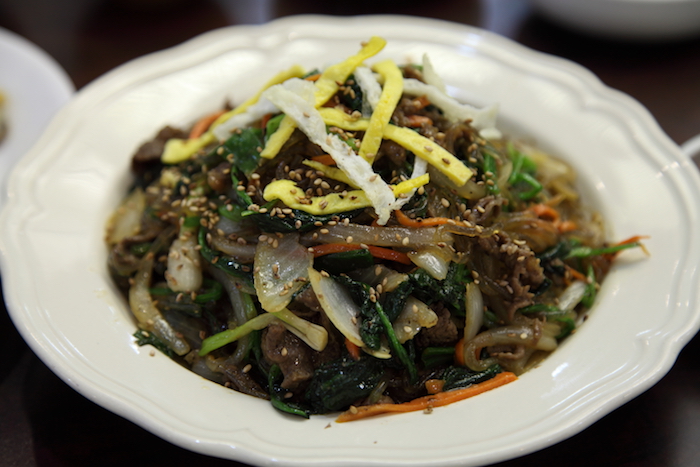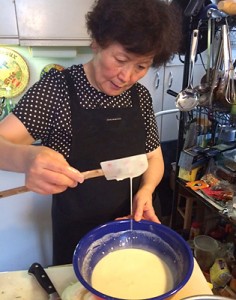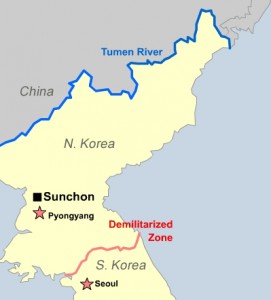By Alan Lake (Jazzfood)
Editor’s Note: This is the 8th installment of Alan Lake’s Home Cookin’ series on home cooks–their stories and recipes. Read part one here for insight into what Home Cookin’ is all about.

Un Hee Han has worked around 70 hours a week for the last 40 years. The land of opportunity has been a brutal mistress. Her version of the American dream plays out in the storefront of a small dry cleaner on Division Street from 7 a.m. to 7 p.m., Monday through Saturday.
You do what you gotta to do.
As the dry cleaner is a block from my apartment, I’ve fallen into friendly conversations with Un Hee in the time it takes to drop off or pick up my clothes. I’ve learned her health is not great–she recently had to wear a heart monitor for months and now has a somewhat painful and erratic pacemaker–and that her daughter spent years recovering from a car accident that hospitalized her for four months.

Invariably, though, we talk about the food I smell when I walk through the door of her store (her packed lunch). A devout Christian, her one day off is for church, where besides praying, she’s been known to cook for the 600-person congregation on occasion.
Her people are North Korean. During the Japanese occupation (1910-1945) the Japanese shut down the universities and required anyone of a certain age to be educated in Japan. So at 15, her father was sent there to study. He came back around 1948, a bad time to be a Christian college boy in Sunchon. This held true for the upper class as well. The communists hated both, and did their best to eliminate them. Being a member of each group, it was time to move. A conservative estimate is that over 100,000 Koreans perished during the “summer of terror” in 1950, and around a half million throughout the war. Better to settle in Seoul where there was less religious and class persecution fostered by the Soviet-backed Democratic People’s Republic in the North.
Post WWII, the main political influences on the Korean peninsula were Russia and the United States. Tension ripened during the Cold War with Korea caught in the middle. Un Hee still has family in North Korea who in their lifetimes have endured first the Japanese occupation, then the Russians and Chinese, and now, the latest oppressive regime.
A born entrepreneur with an undying faith in her Lord, Un Hee can’t relate to socialism at all. Culturally, she’s old-school Korean all the way. Food-wise, though, her heart remains above the 38th parallel.
Preferring the Northern style of cooking, she explains that the food in the landlocked North isn’t as salty or spicy, and rarely fried like in the South. Traditionally, the North uses more wheat and beans, and the South, more seafood and rice, though things have changed with the country’s division. The North is colder and poorer, and with the political situation there, many things are sparse these days. In her father’s day, the two cuisines were distinctive in their own way. Today, at least in the South, it’s more mixed. Hard to say what’s what in the North.
A sickly child, who by her own admission was also spoiled, Un Hee lost her mother when she was three. As an only child, she was doted on by her father and grandmother to the point of over-protection. She says she’s been tough on her daughter as a result, believing it would help prepare her better for a world Un Hee knew nothing of when she left home herself.
Believing she was coming to “paradise,” Un Hee arrived in America in 1973, landing in Kansas City and later Memphis before being drawn to Chicago in 1978, after hearing about a vibrant Korean emigre community on the north side of town (first on Clark Street, and later in Rogers Park). Many old-time Chicagoans fondly remember the new-to-us Korean restaurants on Morse Ave: Poolgogi and Pusan House. I still crave the Seoulmerican breakfast fusion of a poolgogi omelet with cheese and crisp hashbrowns.* These days the community has moved farther west on Lawrence Avenue, and out into the suburbs of Glenview and Northbrook.
At the time, I lived in East Rogers Park and worked at Edgewater Hospital as an entirely ill-suited dialysis technician. Working with dying people played havoc on my spirit, though, and it was my last regular job prior to bluffing my way into a chef position in 1982 (haven’t looked back since.) There were a number of Korean nurses working at Edgewater, a few of which took it upon themselves to teach me to say “hello,” “thank you,” and, “I love you,” in their language–like teaching a pet a trick. They’d say it out loud and write it phonetically on a patient’s chart, and I’d repeat it and be rewarded with food. Tres Pavlovian. Anya ha se yo, Kam se ham ne da, Sa ron hay, scrawled over blood pressure and clotting time stats.
They were forever bringing food to work, and that is how some of my colleagues became some of my friends–by sharing a meal or ten. You want to get to know someone? Sit at a table and eat with them. Kimchi, kimbop, soondubu, galbi and mulmandoo were my passport into Korean culture, with me reciprocating with Romanian Kosher salami and chile rellenos. They loved deli food and pickles of any type. Those in the know knew there was often un grand buffet up in the Nephrology ICU employees’ lounge–one that beat the hell out of the hospital cafeteria.

Cut to today: standing in Un Hee’s store chatting, and over time slowly revealing ourselves–this Home Cookin’ profile was destined to be.
Growing up in Seoul, cooking was an adult affair and the domain of her halmoni (grandmother). Un Hee started cooking here in the U.S. out of need, using the meals in her memory for a connection to a place and time. Self-taught, she cooks in her own style, searching for that stomachful of wonderful she sentimentally remembers: food that resonates to her core. She began weaving together chop chae or bo-ssam in an attempt to satiate her longings for the tastes and flavors of her halmoni . . . and along the way, became quite a cook. Years later, when told of her only grandchild’s cooking abilities, her grandmother scoffed at the notion and died not believing it, having never known her Un Hee to lift a finger in the kitchen.
Here in the States, Un Hee has mainly owned her own businesses, including a store at the Century Mall. The money was better there, but her daughter was young, and long mall hours plus a two-hour bus commute each way led her to rethink careers. She chose dry cleaning over three decades ago because it offered earlier hours, and she briefly retired a few years back.
Her hard work paid off. Her daughter Suzana has done well for herself, having gone to and worked at Northwestern University, and was an editor for CNN. Growing up, she remembers not wanting to bother her mother in any way, so as not to add to her troubles.
“When you watch your mother in tears, exhausted from the struggle of survival, you tend not to complain.”
When Suzana had a near fatal car accident, one of the first things she remembers thinking was, how would she keep this from her mother? Folly though, since she’s had more than a dozen surgeries, spent four months in a hospital/rehab facility, and didn’t walk for a year.
Suzana is caught between the two cultures: her mother’s traditional Korean that insists she live at home until she marries; and the American, in which classmates teased her about her lunch box containing seaweed and odd vegetables redolent with garlic. Quite different from their own Wonder Breaded affairs.
When her mother “conscripts” her to help cook at the church (albeit less frequently now that Un Hee is not in the best of health), Suzana knows their time together is precious and loves learning at her side. Her issue is the insane volume of preparation that goes into cooking for large numbers.
“It’s overwhelming. Never a few, always a pile.”
As good natured as Un Hee is, she’s been a victim of fraud a couple times– most recently losing her life savings by trusting “a bad person.” That’s the reason her retirement was temporary. She lost everything once before as well, about 20 years ago. Between the two, she’s out nearly half a million dollars.
“All my life, money I lose (laughs).”
Her husband went back to Korea in 1979, so Un Hee raised her daughter by herself. He spent seven years in the United States and never worked, so, fed up, she sent him packing back to his parents and they’ve not spoken since. They’re still married, though, because of her strong cultural and religious beliefs regarding divorce. Un Hee tells me that her god helps her, and comforts her in troubled times. Stoic about her misfortunes, she continues to press on and persevere.
While we are cooking at my house, with a chef’s plethora of kitchen equipment spilling from overcrowded counters and shelves, Un Hee spies some knives affixed to a long magnet on the wall. She tells me that she prefers German knives over Japanese. When I ask why, thinking it will be a culinary response, she intimates that it’s because of lingering bad feelings from 35 years of Japanese rule. At the very least, she feels Japan owes Korea an apology for historic misdeeds while treating them as an imperial possession of their then empire–so Henckel and Wüsthof it is. This reminds me of the fight I had with my parents when I was in high school and wanted to buy a Volkswagen–something they vehemently opposed because we’re Jewish.
When asked what she does for fun, Un Hee smiles and says “I lazy, I potato couch.” But she’s not. She’s industrious and devoted, sweet and talented. Un Hee (and tens of millions like her, many of our grandparents included), with their immigrant work ethic and desire to have a life better than they had in the place they left, are well-woven into the American fabric.
“Give us your tired, your poor, your huddled masses yearning to breathe free . . .” That’s a large part of what makes America great, and is something we should cherish and never forget.
In that regard, Un Hee is as American as can be.
(*To satisfy the craving for a poolgoogi omelet with cheese and crispy hash browns, or some excellent bibimbop, one only needs to visit Suzie, the former chef/owner of the aforementioned Pusan House, at her new name/same space digs on Glenwood Avenue, called Noon Hour Grill. Thirty years later, I heard she was there, sought her out and ordered as I did decades ago. Serving me, she took a better look, and I could see it dawning on her that she knew me. Pointing to a couple of college kids sitting there she said, “You used to look like them.”)


